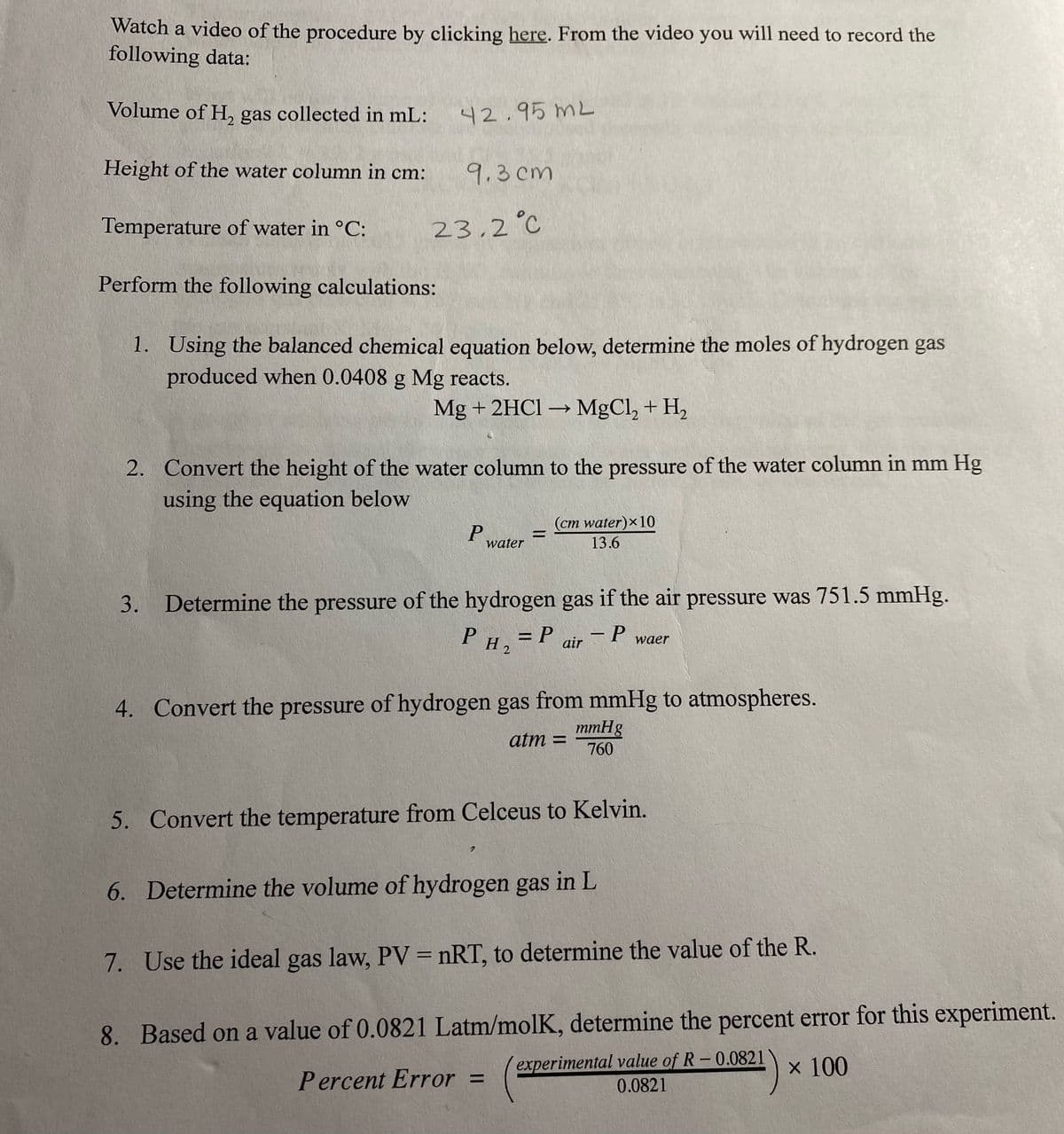Watch a video of the procedure by clicking here. From the video you will need to record the following data: Volume of H, gas collected in mL: 42.95 mL Height of the water column in cm: 9.3 cm Temperature of water in °C: 23,2 °C Perform the following calculations: 1. Using the balanced chemical equation below, determine the moles of hydrogen gas produced when 0.0408 g Mg reacts. Mg + 2HC1 → MgCl, + H2 2. Convert the height of the water column to the pressure of the water column in mm Hg using the equation below (cm water)x10 13.6 %3D water 3. Determine the pressure of the hydrogen gas if the air pressure was 751.5 mmHg. PH, = P air – P %3D waer 4. Convert the pressure of hydrogen gas from mmHg to atmospheres. mmHg 760 atm = 5. Convert the temperature from Celceus to Kelvin. 6. Determine the volume of hydrogen gas in L 7. Use the ideal gas law, PV = nRT, to determine the value of the R. 8. Based on a value of 0.0821 Latm/molK, determine the percent error for this experiment. experimental value of R-0.0821 0.0821 x 100 Percent Error %D
Watch a video of the procedure by clicking here. From the video you will need to record the following data: Volume of H, gas collected in mL: 42.95 mL Height of the water column in cm: 9.3 cm Temperature of water in °C: 23,2 °C Perform the following calculations: 1. Using the balanced chemical equation below, determine the moles of hydrogen gas produced when 0.0408 g Mg reacts. Mg + 2HC1 → MgCl, + H2 2. Convert the height of the water column to the pressure of the water column in mm Hg using the equation below (cm water)x10 13.6 %3D water 3. Determine the pressure of the hydrogen gas if the air pressure was 751.5 mmHg. PH, = P air – P %3D waer 4. Convert the pressure of hydrogen gas from mmHg to atmospheres. mmHg 760 atm = 5. Convert the temperature from Celceus to Kelvin. 6. Determine the volume of hydrogen gas in L 7. Use the ideal gas law, PV = nRT, to determine the value of the R. 8. Based on a value of 0.0821 Latm/molK, determine the percent error for this experiment. experimental value of R-0.0821 0.0821 x 100 Percent Error %D
Chemistry: Principles and Reactions
8th Edition
ISBN:9781305079373
Author:William L. Masterton, Cecile N. Hurley
Publisher:William L. Masterton, Cecile N. Hurley
Chapter5: Gases
Section: Chapter Questions
Problem 78QAP
Related questions
Question
need help with #8, please show work. Thank you

Transcribed Image Text:Watch a video of the procedure by clicking here. From the video you will need to record the
following data:
Volume of H, gas collected in mL:
42.95 mL
Height of the water column in cm:
9.3 cm
Temperature of water in °C:
23,2°C
Perform the following calculations:
1. Using the balanced chemical equation below, determine the moles of hydrogen gas
produced when 0.0408 g Mg reacts.
Mg + 2HC1 → MgCl, + H,
2. Convert the height of the water column to the pressure of the water column in mm Hg
using the equation below
(cm water)x10
water
13.6
3. Determine the pressure of the hydrogen gas if the air pressure was 751.5 mmHg.
= P
P H2
– P
air
waer
4. Convert the pressure of hydrogen gas from mmHg to atmospheres.
mmHg
atm =
760
5. Convert the temperature from Celceus to Kelvin.
6. Determine the volume of hydrogen gas in L
7. Use the ideal gas law, PV = nRT, to determine the value of the R.
8. Based on a value of 0.0821 Latm/molK, determine the percent error for this experiment.
experimental value of R-0.0821
0.0821
x 100
Percent Error =
Expert Solution
This question has been solved!
Explore an expertly crafted, step-by-step solution for a thorough understanding of key concepts.
This is a popular solution!
Trending now
This is a popular solution!
Step by step
Solved in 2 steps

Knowledge Booster
Learn more about
Need a deep-dive on the concept behind this application? Look no further. Learn more about this topic, chemistry and related others by exploring similar questions and additional content below.Recommended textbooks for you

Chemistry: Principles and Reactions
Chemistry
ISBN:
9781305079373
Author:
William L. Masterton, Cecile N. Hurley
Publisher:
Cengage Learning

Chemistry: An Atoms First Approach
Chemistry
ISBN:
9781305079243
Author:
Steven S. Zumdahl, Susan A. Zumdahl
Publisher:
Cengage Learning

Introductory Chemistry: A Foundation
Chemistry
ISBN:
9781337399425
Author:
Steven S. Zumdahl, Donald J. DeCoste
Publisher:
Cengage Learning

Chemistry: Principles and Reactions
Chemistry
ISBN:
9781305079373
Author:
William L. Masterton, Cecile N. Hurley
Publisher:
Cengage Learning

Chemistry: An Atoms First Approach
Chemistry
ISBN:
9781305079243
Author:
Steven S. Zumdahl, Susan A. Zumdahl
Publisher:
Cengage Learning

Introductory Chemistry: A Foundation
Chemistry
ISBN:
9781337399425
Author:
Steven S. Zumdahl, Donald J. DeCoste
Publisher:
Cengage Learning

General Chemistry - Standalone book (MindTap Cour…
Chemistry
ISBN:
9781305580343
Author:
Steven D. Gammon, Ebbing, Darrell Ebbing, Steven D., Darrell; Gammon, Darrell Ebbing; Steven D. Gammon, Darrell D.; Gammon, Ebbing; Steven D. Gammon; Darrell
Publisher:
Cengage Learning

Chemistry by OpenStax (2015-05-04)
Chemistry
ISBN:
9781938168390
Author:
Klaus Theopold, Richard H Langley, Paul Flowers, William R. Robinson, Mark Blaser
Publisher:
OpenStax

Principles of Modern Chemistry
Chemistry
ISBN:
9781305079113
Author:
David W. Oxtoby, H. Pat Gillis, Laurie J. Butler
Publisher:
Cengage Learning